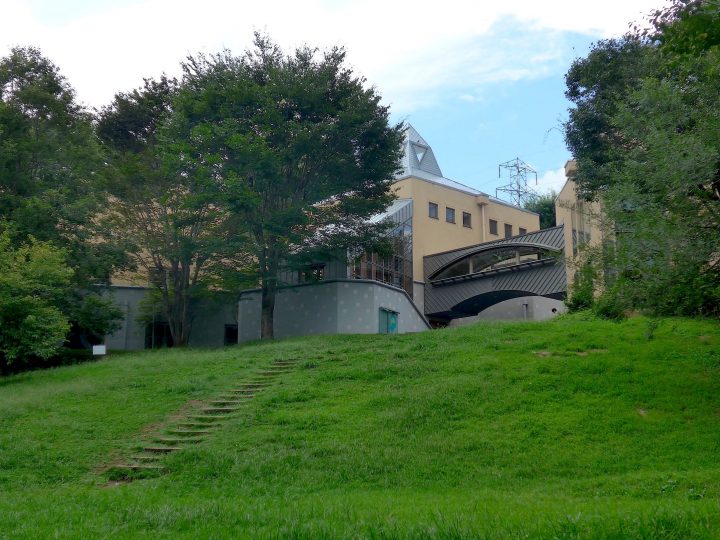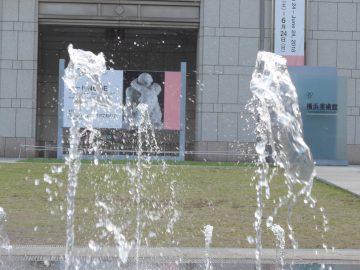Nadegata Instant Party (Toru Nakazaki + Daisuke Yamashiro + Tomoko Noda) presents ENJOY ZOU-NO-HANA 2014 Elephant Shutter Chance ~Say cheese! One-day photo studio~
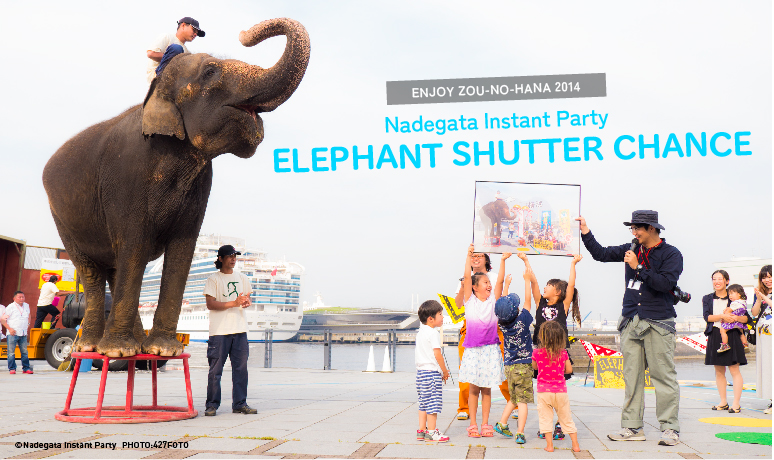
The other day, a one-day-only event, "ENJOY ZOU-NO-HANA 2014 Elephant Shutter Chance ~Say cheese! One-day photo studio~" was held, and under clear skies, Randy the elephant from Ichihara Elephant Kingdom and a total of 15,000 visitors gathered at Zou-no-Hana Park on the day celebrating the 155th anniversary of the port's opening.
The scene of elephants suddenly appearing in Elephant's Trunk Park, a paved space with no cages or fences where various relationships intertwine, created an illusion of the extraordinary, perfect for a festive day.
We at MAGCUL.NET were curious as to how this project came about, so we interviewed the artists who came up with the project, Nakazaki Toru, Yamashiro Daisuke, and Noda Tomoko of Nadegata Instant Party, immediately after the event.
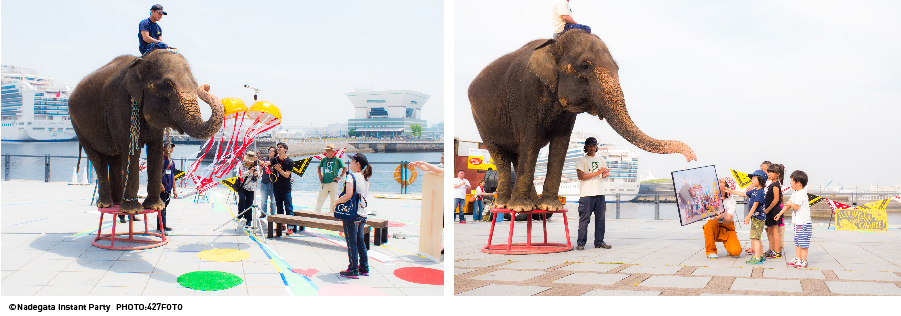
The cameraman would take the picture when Randy the elephant gave the signal to pop the paper lantern. The photos show the test and the presentation of the photos to the group that had actually taken their photos. Was Randy, who popped the paper lantern, taking the photos? Or was the cameraman taking the photos? Or could it be said that the elephant trainer accompanying Randy was taking the photos? It was a pleasant event with a mysterious landscape where various layers overlapped.
- Was it Nadegata Instant Party's (hereinafter Nadegata) suggestion to bring elephants to Zo-no-hana Park this time?
Nakazaki: Well, when we were approached, it had already been decided that we would invite an elephant.
On the other hand, as the organizers, how did you decide to invite the elephants?
Zou-no-hana Terrace Staff: In 2012, we launched the "Enjoy! Zou-no-hana - How to Play with Zou-no-hana" exhibition, and have been proposing ways to have fun that are unique to Zou-no-hana Park, utilizing the creativity of artists such as Yasuhiro Suzuki, Noboru Tsubaki, and the artist unit Me. Since Zou-no-hana Terrace is here, we had been thinking about inviting elephants for a while, but this year also marks the 5th anniversary of the opening of Zou-no-hana Terrace, so we thought we could invite a real elephant with its overwhelming presence as a guest to Zou-no-hana as a special program for "Enjoy! Zou-no-hana 2014," and create a special day spent with an elephant. The staff put all their efforts into making adjustments in various places, and it feels like it's now becoming a reality.
- So, why did you decide to invite the elephants and ask Nadegata to handle the event?
Zou-no-hana Terrace Staff: This time, as a commemorative event for the 5th anniversary of the opening of Zou-no-hana Terrace, we didn't just want to invite elephants, we wanted to create an event that would allow those present to share the magical scenery and experiences of having a real elephant in Zou-no-hana, and to create a memory that would remain for a long time.
Having seen their approach up until now of "creating the perfect 'excuse' for each situation, and then letting that 'excuse' change 'reality'. Turning that process into a story," we thought it would be interesting to see if they could create a participatory piece using a fictional day in which real elephants come as an 'excuse', and so we asked them to create it.
- But on the other hand, it's quite new that all those conditions were met and Nadegata was invited.
Nakazaki: We were also in an identity crisis. When we decided to invite an elephant, you would normally think that it was an artist who came up with the idea, but we really thought about what we could do when we already knew that an elephant was coming.
- For you, Nadegata, in this event, to what extent were you conscious of "creating a work"? Was the idea of "directing" stronger?
Nakazaki: I was worried about "what should be the basis for the work," and I didn't really know. As I was making plans for this project, the location of the elephant's trunk felt like Yokohama, and the fact that an elephant was there was a very strange scene, like a composite. It's a real elephant, but by creating a backdrop that makes it look like a fictional place, or a mechanism that inserts text into the photo like a photo booth, I guess you could say that by creating such a stage set, we at least intervened in the work.
At first, I had imagined a highly entertaining theatrical piece, but if the elephants were there, it would probably work even without us, so I thought that it wasn't the right channel to work with. So I went ahead and made the photographs that were produced in the commemorative photo shoot work as a critical piece.
Yamashiro: This place is really difficult. It's a place where you can easily create a state where there are no boundaries, and because it's an open, free space, everyone thinks that anyone can enter, and it's also a public place. Because everyone here has that kind of feeling, I thought that everyone must have had a hard time when they wanted to create a special space here. So, this time, having the elephant here and being able to make it work has made it a little easier for us.
- Please tell us how this event came to be.
Noda: As we talked, the conversation shifted from having the elephant come and doing something with the elephant to asking what we could have the elephant do.
Nakazaki: Randy gave me a list of all the tricks he could do...
Noda: That's right. There were things like balloons being thrown or lifts being made.
So we started thinking about giving the elephant itself a role and doing something.
Nakazaki: I thought we should intervene as little as possible. We thought of this event as a 2-3 hour show, but we also thought that there wouldn't be any audience watching the whole time.
Noda: I tried to make the structure itself easy to understand, so that even customers who just happen to come in can understand after just a quick look, "Oh, so the elephant is the cameraman."
Nakazaki: There was a live performance with an elephant, but I wanted to take a photo that would have a mix of reality and virtuality. Depending on how it's put together, the video and documentary footage could potentially become original.
- Ultimately, the biggest takeaway is the photos and videos that come out of the event, rather than the actual event itself. Will those records be exhibited?
Noda: Yes. The photos we took this time will be on display from the 14th.
Nakazaki: We may also exhibit the objects used as part of the set.
*Elephant Shutter Chance ~Say Cheese! One-Day Photo Studio~ documentary exhibition
Date: June 14th (Sat) - June 29th (Sun) 10:00-18:00
Venue: Zou-no-hana Terrace
- Please tell us your honest thoughts now that the event has concluded.
Nakazaki: I don't actually understand humans, but I think I do, and I want to understand them, but with elephants I had a strong feeling of "I don't understand them," and I thought, "There aren't many other people like them around me" (laughs). I thought it was a good thing to feel close to these creatures.
Yamashiro: It's true that the strategy of "bringing in someone who will never understand" could be an interesting one.
Noda: That's right. We live in a completely different dimension.
Yamashiro: Usually the elephants are separated by a cage, so we see them as if they were in a different world, so it felt really strange to see them in the center and together like this time.
Nakazaki: But if you say that, then we are also in a situation where we would not normally be able to understand each other, and that is easy to understand, but also confusing.
But it's not like it's all bad.
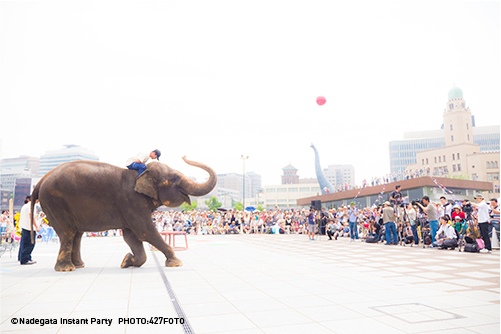
Randy was surrounded by a variety of people, including people who happened to be passing by, people who came to watch, and the event staff, but Randy was completely unfazed. His natural behavior transformed the extraordinary scene of "an elephant on the seashore" into an even more mysterious space. During the event, the many spectators simply gazed on Randy eating and bathing in fascination, creating a space filled with an indescribable sense of happiness.
- Do you have any plans to use this technique of introducing characters who you can't understand into your work in the future?
Nakazaki: The work I made last week also had a group photograph motif, and this event is linked to that.
Noda: As Nakazaki said earlier, I think the key to this project was the "incomprehensibility of elephants." So I don't know if it will be adopted as a method, but I feel that it has potential.
- I think it's great that this event went smoothly without any accidents, but as time is running out I'd like to close this article by asking you to say a few words in closing.
Yamashiro: I'm really happy that I was able to direct this kind of day (laughs).
Nakazaki: I think coexisting with a larger other is similar to the appeal of art, where you take an interest in something you don't understand and take a step forward to interact with it, or where you accept the existence of things you cannot judge within yourself. I think today was a day like that. I think we were able to create such a space.
/////////////////////////////////////////////////// /////////////////////////////////////////////////// /////////////////////////////////////////////////// ////////////
[Editor's Note]
The expression "incomprehensibility" was used in the conversation, but I still don't fully understand what that "incomprehensibility" was.
Randy was surrounded by a large number of different people, including artists, passing tourists, participants, and people involved in the event, but the atmosphere was "Randy is the usual Randy," creating an indescribable sense of happiness, and perhaps only those who were there in person could understand that "extremely unnatural sense of happiness."
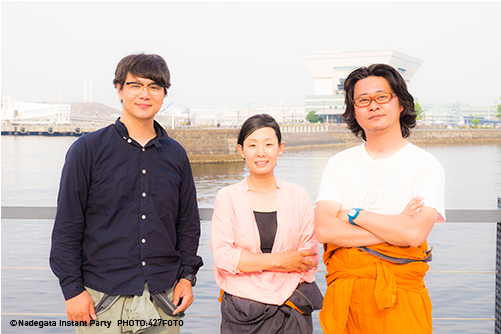
Members of Nadegata Instant Party after the event. From left: Daisuke Yamashiro, Tomoko Noda, and Toru Nakazaki
Nadegata Instant Party (Toru Nakazaki + Daisuke Yamashiro + Tomoko Noda)
An artist unit consisting of visual artists Toru Nakazaki (born in Ibaraki in 1976), Daisuke Yamashiro (born in Osaka in 1983), and art manager Tomoko Noda (born in Gifu in 1983). They create the optimal "excuse" for the location and situation in which the project is carried out, and create an event as "reality" by involving many participants in order to achieve the purpose of the excuse. They create a story about the process in which "reality" changes depending on the "excuse," and develop their works by combining documentary, theatrical techniques, installations, etc. Representative works include 24 OUR TELEVISION (2010), a 24-hour internet television station that involved over 100 local staff members and local media (Aomori Contemporary Art Center), COUNTRY ROAD SHOW (MOT Annual 2012 Making Situations, Editing Landscapes, When the Wind Blows, the Barrel Maker Makes Money) (Museum of Contemporary Art Tokyo) (2012), and STUDIO TUBE (Aichi Triennale 2013) (former site of Chubu Electric Power Honmachi Switchyard) (2013). He is scheduled to participate in Rokko Meet Art 2014, which will be held in Hyogo Prefecture in September.


